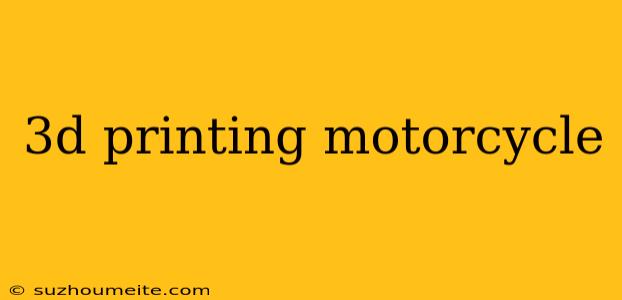Revolutionizing the Motorcycle Industry: The Rise of 3D Printing
Introduction
The motorcycle industry has witnessed a significant transformation in recent years, with the advent of 3D printing technology. This innovative manufacturing process has enabled the creation of complex motorcycle parts, reducing production time, and costs. In this article, we will explore the benefits and possibilities of 3D printing in the motorcycle industry.
What is 3D Printing?
3D printing, also known as additive manufacturing, is a process of creating a three-dimensional solid object from a digital file. This is achieved by layering materials such as plastics, metals, and ceramics according to the design specifications. 3D printing has been widely adopted in various industries, including aerospace, automotive, and healthcare.
Benefits of 3D Printing in Motorcycle Manufacturing
Reduced Production Time
3D printing enables rapid prototyping and production, reducing the time required to develop and manufacture motorcycle parts. This accelerated process allows designers and engineers to test and iterate on designs quickly, streamlining the entire production cycle.
Increased Customization
3D printing allows for the creation of customized motorcycle parts, tailoring to individual riders' preferences. This level of personalization is not feasible with traditional manufacturing methods, making 3D printing an attractive option for motorcycle enthusiasts.
Cost-Effective
3D printing eliminates the need for molds, tooling, and other expensive equipment required for traditional manufacturing. This significantly reduces production costs, making it an economical option for small-batch or one-off productions.
Weight Reduction
3D printing allows for the creation of complex geometries and structures, enabling the design of lighter yet stronger motorcycle parts. This weight reduction can lead to improved fuel efficiency, handling, and overall performance.
Sustainability
3D printing produces minimal waste, reducing the environmental impact of motorcycle manufacturing. Additionally, the use of recyclable materials and energy-efficient processes further emphasizes the eco-friendly nature of 3D printing.
Challenges and Limitations
Material Properties
The mechanical properties of 3D printed materials are still being developed and refined. Ensuring the durability and reliability of 3D printed parts remains a significant challenge.
Regulatory Frameworks
The lack of standardized regulations and certifications for 3D printed motorcycle parts poses a significant hurdle for widespread adoption.
Scalability
Currently, 3D printing technology is limited by its scalability, making it difficult to produce large quantities of parts efficiently.
Real-World Applications
Custom Motorcycle Parts
Companies like Ducati and BMW are already utilizing 3D printing to create customized motorcycle parts, such as engine components, fairings, and seats.
Racing Applications
3D printed parts are being used in professional racing, where the need for high-performance, lightweight components is paramount.
Prototyping and Testing
3D printing is being used to rapidly prototype and test motorcycle designs, reducing the time and costs associated with traditional prototyping methods.
Conclusion
The integration of 3D printing technology in the motorcycle industry is poised to revolutionize the way motorcycles are designed, manufactured, and customized. While challenges and limitations exist, the benefits of 3D printing are undeniable. As the technology continues to evolve, we can expect to see increased adoption and innovative applications in the motorcycle industry.
